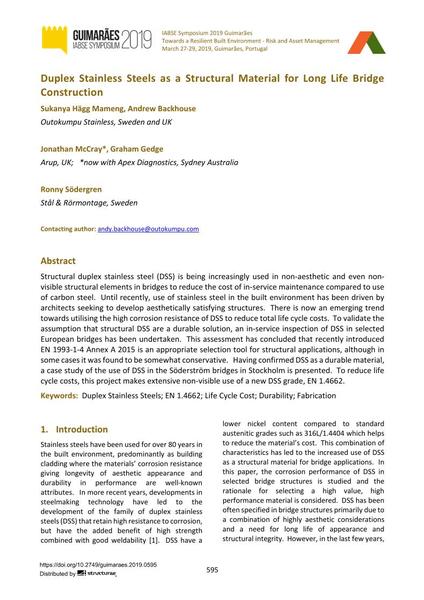Duplex Stainless Steels as a Structural Material for Long Life Bridge Construction

|
|
|||||||||||
Détails bibliographiques
| Auteur(s): |
Sukanya Hägg Mameng
(Outokumpu Stainless, Sweden and UK)
Andrew Backhouse (Outokumpu Stainless, Sweden and UK) Jonathan McCray (Arup, UK; *now with Apex Diagnostics, Sydney Australia) Graham Gedge (Arup, UK; *now with Apex Diagnostics, Sydney Australia) Ronny Södergren (Stål & Rörmontage, Sweden) |
||||
|---|---|---|---|---|---|
| Médium: | papier de conférence | ||||
| Langue(s): | anglais | ||||
| Conférence: | IABSE Symposium: Towards a Resilient Built Environment Risk and Asset Management, Guimarães, Portugal, 27-29 March 2019 | ||||
| Publié dans: | IABSE Symposium Guimarães 2019 | ||||
|
|||||
| Page(s): | 595-602 | ||||
| Nombre total de pages (du PDF): | 8 | ||||
| DOI: | 10.2749/guimaraes.2019.0595 | ||||
| Abstrait: |
Structural duplex stainless steel (DSS) is being increasingly used in non-aesthetic and even non- visible structural elements in bridges to reduce the cost of in-service maintenance compared to use of carbon steel. Until recently, use of stainless steel in the built environment has been driven by architects seeking to develop aesthetically satisfying structures. There is now an emerging trend towards utilising the high corrosion resistance of DSS to reduce total life cycle costs. To validate the assumption that structural DSS are a durable solution, an in-service inspection of DSS in selected European bridges has been undertaken. This assessment has concluded that recently introduced EN 1993-1-4 Annex A 2015 is an appropriate selection tool for structural applications, although in some cases it was found to be somewhat conservative. Having confirmed DSS as a durable material, a case study of the use of DSS in the Söderström bridges in Stockholm is presented. To reduce life cycle costs, this project makes extensive non-visible use of a new DSS grade, EN 1.4662. |
||||

